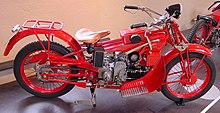The
Cagiva (from
CAstiglioni
GIovanni
VArese) company, founded by the Castiglioni brothers, needed an engine - while
Ducati, who had just been released from a difficult past of statutory public management (IRI), needed revenue.
Over a series of Italian style meetings/lunches in 1984, they agreed a deal for Ducati to supply engines to Cagiva - and then go out of the business of producing motorcycles. However, the Castiglioni brothers of Cagiva were eventually offered a deal to buy Ducati, subject to the Ducati name living on as an actual motorcycle product. On closure of the deal, Ducati engines were instantly installed in a number of
Cagiva bikes, which included the Alazzurra and the Elephant enduro bike.
At the time of the takeover, due to its financial difficulties Ducati was in a state of suspended animation with regards to engineering development. By that time, the classic bevel drive
V-twin, which was old and expensive to produce, had been replaced by the belt-drive
Pantah, designed by
Fabio Taglioni. The Pantah was already known to be a strong and capable engine, and known to deliver in the Ducati 750 F1.
The Pantah engine has been constantly developed up to the present day, and remains the only production motorcycle equipped with
desmodromic valves. And around it they wanted a Ducati motorcycle unlike any other, that showed the world both Ducati's capabilities, and where it would go in the future.
Unfortunately commercial success didn't come, and worldwide the Paso 750 only sold 4,863 units between its introduction in 1986 and 1988. The Paso was more expensive and had lower performance (72.5 hp and 210 km/h top speed) than its competitors, and had some reliability and rideability problems with the electrical and fuel systems, due to the use of an automotive
Weber carburetor, which was ill-suited to a small-capacity motorcycle engine.
In 1989 the
Paso 906 was introduced to replace the 750, with a six-speed
gearbox, a 904 cc engine which provided 88 hp and a 220 km/h top speed. The bike still had the same automotive carburettor and unreliable electrical system, but its greatest development was the incorporation of
liquid cooling. 1,802 Paso 906's were built between 1988 and 1989.
After further development, the final version of the design came in 1990 with the
907IE (Iniezione Elettronica); now without the name "Paso". The engine remained liquid-cooled and the carburetor was replaced by the most modern Weber-Marelli IAW 043 system that integrated ignition and electronic
fuel injection, which transformed the rideability of the bike. Power increased to 90 hp and top speed to 230 km/h. The wheels were changed to 17 inches, giving the bike more stability.
Despite these advances sales of this model remained sluggish, and when production ceased in 1992 only 2,303 907IE's had been built.








 Old Kawasaki Ninja 250r
Old Kawasaki Ninja 250r


















